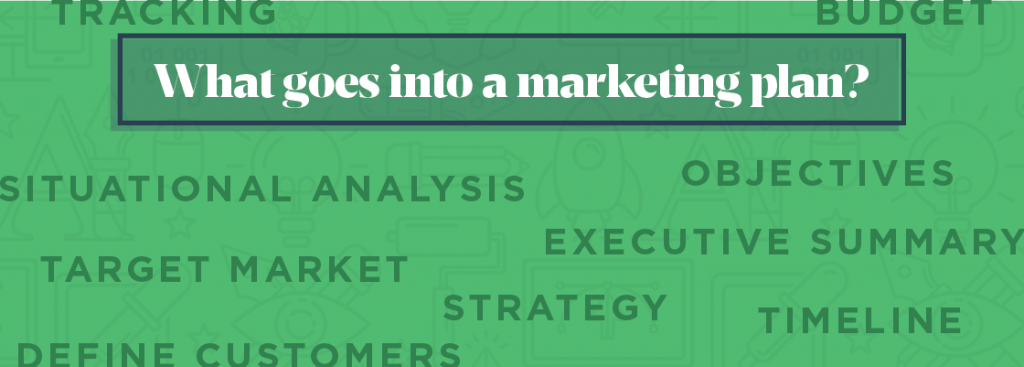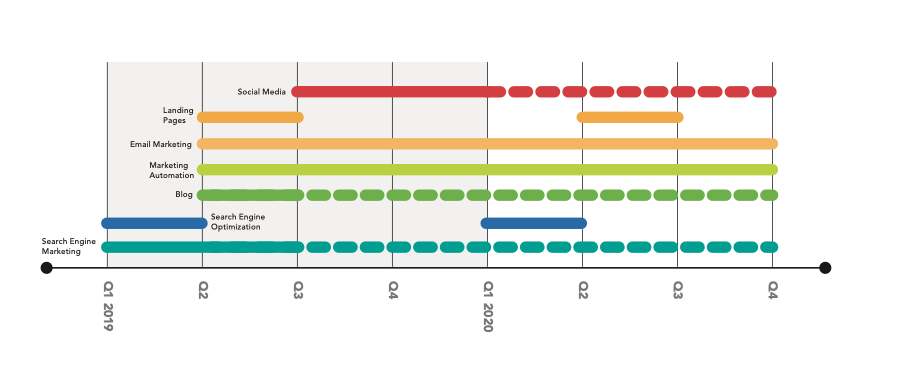- Marketing 101

Do you have a plan, or is your marketing just a shot in the dark?
50% of small businesses do not have a marketing plan. What these organizations don’t know is how significantly the presence—or lack—of a marketing plan can impact their bottom lines.
Here’s why you need a marketing plan and how to create one.

WHAT IS A MARKETING PLAN
Let’s start this out by defining “marketing plan.”
This might be a little (or a lot) obvious, but a marketing plan is a document that describes how you plan to market your business.
Here’s a more comprehensive definition. Since we don’t want to reinvent the wheel, we borrowed a great one from Venngage:
“A marketing plan is a report that outlines your marketing strategy for the coming year, quarter or month. Typically, a marketing plan will include these elements:
- An overview of your business’s marketing and advertising goals
- A description of your business’s current marketing position
- A timeline of when tasks within your strategy will be completed
- Key performance indicators you will be tracking
- A description of your business’s target market and customer needs”
We’ll go over these components in detail later.

WHY YOU NEED A MARKETING PLAN
What’s the point of having a marketing plan? Why write down everything you’re planning to do when it’s already in your head?
There are many reasons:
1. Identify Goals
Goals tend to be a bit nebulous until they’re written down and tied to specific actions. If your objective is to “get more leads,” but you haven’t pinpointed which steps you’ll take to make it happen, it’s a wish—not a goal. And if you haven’t decided on specifics, how will you truly know if you’ve achieved your goal?
This is where SMART (Specific, Measurable, Attainable, Relevant, and Time-Bound) goals come in. Here’s an example from 2 Fish Company’s marketing plan:
Increase email subscribership by 25% by the end of 2020.
This goal is specific (we want 25% more email subscribers), measurable (if we hit that magic number, we know we’ve succeeded), attainable (an increase of 25% is not outside of the realm of possibility), relevant (more email subscribers will help us get more leads and achieve business goals), and time-bound (we want to achieve this goal in 2020).
2. Outline Strategy
Once you know the specific goals you and your company want to achieve, you can start to plan how to achieve them. If you know that you want more email subscribers, you can then think up strategies and tactics for attracting them. Take this example from 2 Fish Co’s plan, for instance:
| Strategy | Tactic |
| Content Marketing |
|
Now we have an actionable strategy for reaching more members of our audience and encouraging them to sign up for our email list (by offering helpful content).
3. Stay Accountable
We get it; it’s easy to have grand marketing ideas and then run out of time or budget to follow through. By creating a plan with specific strategies and then attaching realistic budgets and project timelines to it, you’ll be poised to make things happen, keeping you accountable to yourself and your organization.
Truth time: 2 Fish Company fell into “ad hoc marketing” for several years. We’re focused on getting things done for our clients, so naturally, we put their work above our own. Whenever we had some open time or a new idea for how we could market ourselves, we would rush to put something together. Our efforts weren’t consistent.
By not investing the time in creating an actual marketing plan, we were not effectively or efficiently marketing ourselves. Now that we are proactive versus reactive, we save time and money, and we can still be agile when needed.
4. Benchmark Performance
Having specific goals, strategies, and tactics allows you to track your progress against your objectives. Once you clearly identify your goals, you’ll be able to know when you’ve achieved them, which tactics helped you do so, and which didn’t.
This is powerful knowledge. Not only will it inform tactics to focus on going forward, but it will also help you back up your future marketing decisions.
(We’ll discuss how to track performance under “What to Include in Your Marketing Plan.”)
5. Prove Success (Or Strategy Pivots)
Last, but certainly not least, having a marketing plan enables you to prove the success of your strategies.
Proving ROI is the eternal marketing struggle. While some outcomes will always be hard to track (for example, the indirect benefits of social media), others are easy as long as you have a plan in place to capture the data.
In 2 Fish Company’s marketing plan, we attach key performance indicators (KPIs) to each goal. Take this website sessions goal, for instance:
Increase average session time by 20% and increase number of session times over 60 seconds by 50%.
KPI: Avg. Session Duration, Session Duration (by seconds)
We create performance check-up reports at the end of each month that track progress toward these goals using the relevant KPIs.
Your marketing plan also allows you to identify which strategies or tactics did not work, informing you of pivots that may be necessary and then arming you with information to defend those changes should you need to. “This tactic isn’t working, and I have the numbers to prove it” is much stronger than “I have a feeling this isn’t working.”

WHAT TO INCLUDE IN YOUR MARKETING PLAN
You know why you need a marketing plan, so let’s get into the nitty-gritty of actually making one. These are the basic components to include:
Executive Summary
- An overview of the document, pulling out key points. (We like to make ours a bullet list for readability.)
- Written last.
Situational Analysis:
NOTE: We like to put the situational analysis first to give context to marketing strategies to follow, but some organizations prefer to lead with objectives.
- Provide information about your organization’s current performance and position in the market. Include any relevant research on competitors.
- Perform a SWOT (strengths, weaknesses, opportunities, and threats) analysis.
Define Customers/Target Market
- Clearly define your target market by creating customer personas.
Objectives
- Outline your SMART goals.
- Include relevant KPIs.
Strategy
- Outline your high-level strategies.
- Dig into tactics within each strategy area, providing specifics of how you will use the strategy to achieve goals. Here are a few examples of strategies and tactics designed to help 2 Fish Company achieve website-related goals:
| Strategy | Tactics |
| Website Support |
|
| Search Engine Marketing |
|
Tracking
- Set a plan for how you will measure performance. You’ve established which KPIs you’ll be tracking. How will you get that information? We use tools like Google Analytics (for website performance metrics), Google Ads (for SEM performance metrics), and Rival IQ (for social media performance metrics).
- How often will you be measuring? We like weekly checkups, monthly overview reports, and quarterly strategy reviews.
- Set contingencies in case something doesn’t work. Organic social media not moving the needle? Consider planning in next steps, such as scaling back and shifting budget to social ads.
Timeline
- Creating implementation timelines allows you to distribute tactics throughout the year as budget and time permit.

We like to accompany our marketing plans with a yearly calendar outlining all efforts. Check frequently to make sure you know what needs to get done when.
Budget
- Budget is a crucial aspect of a marketing plan. Setting a budget helps you be realistic about what can be achieved and in what time frame. Having hard numbers also helps you stick to them, whereas ad hoc marketing efforts may end up exceeding what you’d hoped to spend.
- Keep in mind that a marketing spend of 1-3% of topline sales is considered a safe, “treading water” spend. 3-5% of revenue is reserved for moderate growth activity. Aggressive growth goals usually utilize 5-7+% of revenue.

MAKE IT YOUR OWN
Here’s the catch: Every marketing plan does not look the same. There may be some components here that you don’t feel that you need. Create a marketing plan that makes sense for your organization.
Another caveat: If you’re reading this midyear, don’t push off a marketing plan until next year. Pick up where you can.
We invite you to reach out with any questions you may still have about creating a marketing plan, or to let us know how your new plan has impacted your organization!
Be sure to check out more Marketing 101 content and subscribe to be notified right away when new content is released!
Remember, you can always submit questions for us to cover!
SHARE IT!
-
Marketing 101
Marketing 101: How to Make Social Marketing Work for You
-
Marketing 101
Marketing 101: Why You Need Personas + How To Create Them




